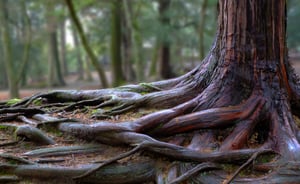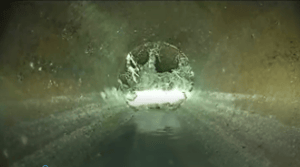Root intrusion is a common cause of sewer pipe damage. If not properly addressed, root-related issues can wreak havoc on a municipality’s wastewater collection system. Luckily, there are many solutions available to municipalities looking to implement root control measures.
How Do Roots Grow Into Sewers?

Plant roots serve several functions: They anchor and keep the plant upright, store food for the plant, and absorb and conduct water and nutrients. As such, roots are in constant search of moist, nutritious environments that will keep the plant alive.
Root tips are extremely sensitive and can detect differences in nutrient and moisture levels in their surrounding soil. Roots will grow towards more appealing areas. Sewer pipes attract root growth because they are often warmer than their surrounding environments and may leak water.
There are different types of roots, each of which poses unique threats to sewer systems. Feeder roots are thin, hair-like structures that can penetrate tiny openings such as cracks or connections between pipes. Secondary roots are larger, thicker roots that can follow a sewer pipe for many feet in search of any openings. If secondary roots do enter sewer pipes, they can exert enough pressure to spread out pipe joints or even break pipes.
How Is Root Damage Identified?
Sewer blockages and overflows are common ways that municipalities or homeowners discover root problems. Sewers with an increased likelihood of root issues include sewers located near other collection systems with known root problems, and sewers made with loose-fitting joints or outdated joint packing materials.
 Unless they cause obvious flow problems or discharges, structural damage caused by roots often goes unnoticed until lines are assessed during routine inspections and cleaning. CCTV crawlers may identify root damage in main lines, while lateral launch systems or push cameras are typically used to locate defects in laterals and smaller pipes.
Unless they cause obvious flow problems or discharges, structural damage caused by roots often goes unnoticed until lines are assessed during routine inspections and cleaning. CCTV crawlers may identify root damage in main lines, while lateral launch systems or push cameras are typically used to locate defects in laterals and smaller pipes.
How Much Does Root Damage Cost Communities?
Structural damages caused by root intrusion are costly to fix, as is the process of replacing pipes. According to New Flow Plumbing, “The usual cost of the average professional tree root removal from a [lateral] sewer line will probably be somewhere between $650 and $750.” On average, root removal costs around $50-$200 for each foot of lateral treated. Clearing roots or other debris from a sewer main can vary greatly depending on the tools used, the type of pipe, and the severity of the clog. And because plant growth is constant, mitigating the damage caused by roots often requires regular, ongoing attention.
How Is Root Damage in Sewers Prevented?
Municipalities should implement early preventative root control measures to avoid root damage from the get-go. Common preventative measures include
- Discriminately planting trees away from proposed or existing sewer lines.
- Careful installation of connections between laterals and main lines to ensure that piping is sealed properly.
- Building out GIS records and creating scattergrams that include both major plant growth and underground assets, so that high-risk areas can be prioritized for inspection or rehab.
How to Treat Root Damage in Sewers
 Utilities rely on many different methods to treat sewer lines once root damage is identified. Physical treatment options include permanent solutions such as tree removal, pipe replacement, or sewer pipe relining. Also common are mechanical treatments, such as the use of drill machines, drag/bucket machines, chain cutters, and/or high-pressure jetters. Waterjet root cutters are particularly helpful; they drive circular saw blades through a pipe using hydraulic power, both cleaning and clearing out the pipe. These machines are best for opening clogged sewers and for removing roots that are at risk of blocking sewers. However, these methods are only short-term fixes, so they are often used alongside chemical control measures.
Utilities rely on many different methods to treat sewer lines once root damage is identified. Physical treatment options include permanent solutions such as tree removal, pipe replacement, or sewer pipe relining. Also common are mechanical treatments, such as the use of drill machines, drag/bucket machines, chain cutters, and/or high-pressure jetters. Waterjet root cutters are particularly helpful; they drive circular saw blades through a pipe using hydraulic power, both cleaning and clearing out the pipe. These machines are best for opening clogged sewers and for removing roots that are at risk of blocking sewers. However, these methods are only short-term fixes, so they are often used alongside chemical control measures.
Chemical methods of root control typically produce more effective results than non-chemical measures; chemicals can kill roots beyond the point of contact, meaning they can control root growth outside of the sewer pipe. Herbicides such as metam-sodium and dichlobenil are commonly used for root control. However, these chemicals carry certain risks. Metam-sodium, for example, is highly toxic and can cause acute illness in humans. For safety reasons, these chemicals should only be applied by certified professionals. Note that pesticide registration varies regionally, so it is best practice for public works officials and drain cleaners to check in with their local authorities before applying any herbicides.
After roots have been killed by pesticide application, microbes break down the plant dead tissue, and the decomposed organic matter enters the wastewater stream to be carried to the treatment facility. Chemical treatments may need to be repeated at three to five year intervals, as some roots will begin to regrow several years after treatment.
Root damage is a serious problem facing many municipalities. To keep sewers flowing and clear of roots, public works should implement basic preventive measures and conduct regular inspections of their systems. Verisight Pro+ is the municipal grade push camera that captures detailed footage under challenging conditions, and its accessible interface offers robust tools—including observation entry and reporting options—as well as USB and SD media interfaces for easy transfer of data, video, images and reports. Schedule a demo to learn more:

